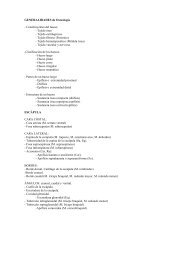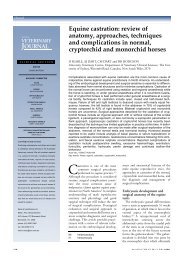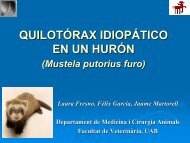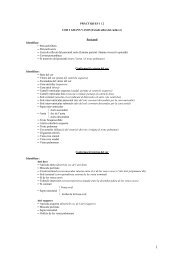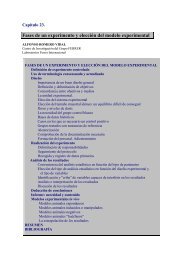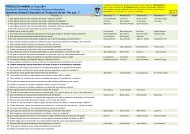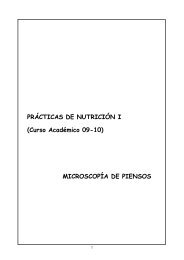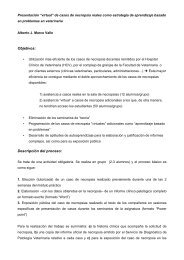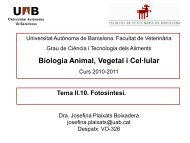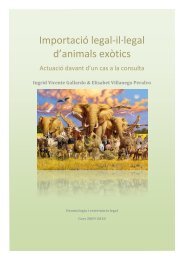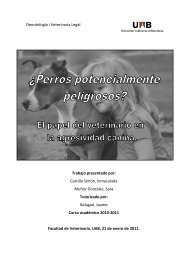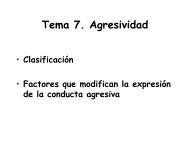SPONGES (Branches of the tree of life, BioMEDIA ASSOCIATES, Bea
SPONGES (Branches of the tree of life, BioMEDIA ASSOCIATES, Bea
SPONGES (Branches of the tree of life, BioMEDIA ASSOCIATES, Bea
Create successful ePaper yourself
Turn your PDF publications into a flip-book with our unique Google optimized e-Paper software.
Class HexactinellidaHexactinellid sponges are fairly common, but not so easy to see. To find <strong>the</strong>m you mayneed to join a well-equipped expedition such as this. The team sets out to survey <strong>life</strong> at<strong>the</strong> bottom, 200 meters below. What <strong>the</strong>y discovered are huge reefs composed almostentirely <strong>of</strong> hexactinellid sponges. Core samples from <strong>the</strong> base <strong>of</strong> <strong>the</strong> sponge reef indicateover 9000 years <strong>of</strong> continuously growth. It’s entirely possible that individual spongesseen here at <strong>the</strong> top <strong>of</strong> <strong>the</strong> reef have grown for hundreds or even thousands <strong>of</strong> years.The tissue <strong>of</strong> hexactinellids it not cellular but a mass <strong>of</strong> cytoplasm containing thousands<strong>of</strong> nuclei. The term <strong>of</strong> this is syncytial. These sponges are also called glass sponges.Their glass spicules are usually six- pointed, long and thin, tightly meshed around <strong>the</strong>syncytial tissues. Remove <strong>the</strong> tissue from a glass sponge and you will be left with anintricate glass skeleton.Class DemospongiaClass Demospongia includes sponges with two different types <strong>of</strong> skeleton. You mayhave rubbed one skeleton type against your skin. Bath sponges were traditionally madefrom warm-water marine sponges, by chemically removing <strong>the</strong> cellular tissue. A thinsection reveals <strong>the</strong> skeleton – a matrix <strong>of</strong> linked fibres made <strong>of</strong> a flexible protein,collagen.The second group <strong>of</strong> demosponges have spicules made <strong>of</strong> silica, <strong>the</strong> same materialfound in glass; while HCl acid dissolves <strong>the</strong> spicules <strong>of</strong> calcereous sponges, it has noeffect on <strong>the</strong> glass spicules <strong>of</strong> demosponges.Class Demospongia is by far <strong>the</strong> largest group <strong>of</strong> sponges. Members <strong>of</strong> this group are<strong>the</strong> most common incrusting species, and upright forms, such as <strong>the</strong> barrel sponges, areabundant on coral reefs.There are over 7000 known species <strong>of</strong> desmosponges, and it is estimated that <strong>the</strong>re maybe just as many species yet to be described.EcologySponges are permanently attached to <strong>the</strong> ocean floor, so why aren’t <strong>the</strong>y easy prey forhungry predators? The answer is simple: sponges have evolved remarkable abilities toproduce poisons. To most marine predators <strong>the</strong>y probably taste and smell very bad. Butone group <strong>of</strong> predators is not easily foiled: nudibranchs or see slugs have two organs on<strong>the</strong> top <strong>of</strong> <strong>the</strong> head that detect <strong>the</strong> smell <strong>of</strong> <strong>the</strong> sponge prey. The nudibranch not onlyeats <strong>the</strong> sponge, it stores <strong>the</strong> sponge poisons in its own tissue, <strong>the</strong>reby stealing <strong>the</strong>defence <strong>of</strong> its prey. Many nudibranchs add ano<strong>the</strong>r line <strong>of</strong> defence, looking so like <strong>the</strong>irsponge prey <strong>the</strong>y become hidden from predators. This nudibranch even hides its eggs on<strong>the</strong> surface <strong>of</strong> its food. But o<strong>the</strong>r sponge-eating nudibranchs seem advertise <strong>the</strong>mselves–probably benefiting when predators learn <strong>the</strong>y taste like poisonous sponge.This sponge has suffered severe wounding, but in a few months it will repair itself,regenerating lost tissue. Using <strong>the</strong> same power <strong>of</strong> regeneration, some sponges dispersefragments that grow into new individuals, a form <strong>of</strong> asexual reproduction. Ano<strong>the</strong>r form<strong>of</strong> asexual reproduction involves <strong>the</strong> formation <strong>of</strong> gemmules by some marine spongesand most freshwater sponges. Gemmules are produced in <strong>the</strong> late fall and <strong>the</strong> spongetissue around <strong>the</strong>m disintegrates. In spring, a new clone <strong>of</strong> <strong>the</strong> sponge grows up out <strong>of</strong><strong>the</strong> gemmule.Occasionally, sponges reproduce sexually; when <strong>the</strong> stimulus is right, cells in <strong>the</strong>sponge become sperm, which are shed into <strong>the</strong> water. Of <strong>the</strong> millions <strong>of</strong> sperm released,some are taken in by a <strong>the</strong> receptive sponge, where <strong>the</strong>y fertilize eggs inside <strong>the</strong> tissue.The larvae develop for a few days, and <strong>the</strong>n break out. They swim for a few hours, and<strong>the</strong>n settle to <strong>the</strong> bottom, where <strong>the</strong>y begin a new sponge.
The simplest living animals provide clues to <strong>the</strong> origin <strong>of</strong> <strong>the</strong> animal kingdom. In fact,rocks dated around 600 million years ago show fossils <strong>of</strong> simple sponges. Older rocksshow ancient Earth teaming with single-cell <strong>life</strong>, and single colonies, but nomulticellular animals. Did animals evolve many times from different single-celledancestors? Or did <strong>the</strong>y evolve just once?Recent studies from genes from all animals groups show clearly that <strong>the</strong> answer is justonce, and that sponges are at <strong>the</strong> very base <strong>of</strong> <strong>the</strong> animal <strong>tree</strong> <strong>of</strong> <strong>life</strong>. So <strong>the</strong> first animalwas a sponge, and all o<strong>the</strong>r animals descended from this ancestor. But what about <strong>the</strong>single-celled ancestor <strong>of</strong> that ancient sponge. You can search for its living relatives in apond near you. These simple colonies, choan<strong>of</strong>lagellates, are made <strong>of</strong> cells that lookvery much like collar cells. Gene studies reveal that sponges and choan<strong>of</strong>lagellates arevery closely related, making choan<strong>of</strong>lagellates our nearest protist ancestors.Sponges are simple animals with no organs, and just a few cell types, including one thatis unique, <strong>the</strong> flagellated collar cell or choanocyte.Sponges are an ancient line <strong>of</strong> animals, a line that evolved at least 600 million years ago,and gave rise to <strong>the</strong> three main groups <strong>of</strong> living sponges: calcerea, hexactinellida anddemospongia. They’re found in all aquatic environments, but are far more diverse andabundant in oceans than in freshwater.Despite <strong>the</strong>ir simplicity, sponges are colourful and diverse, and <strong>the</strong>y are very successful,with as many as 15000 species living through <strong>the</strong> world oceans and in freshwater.




